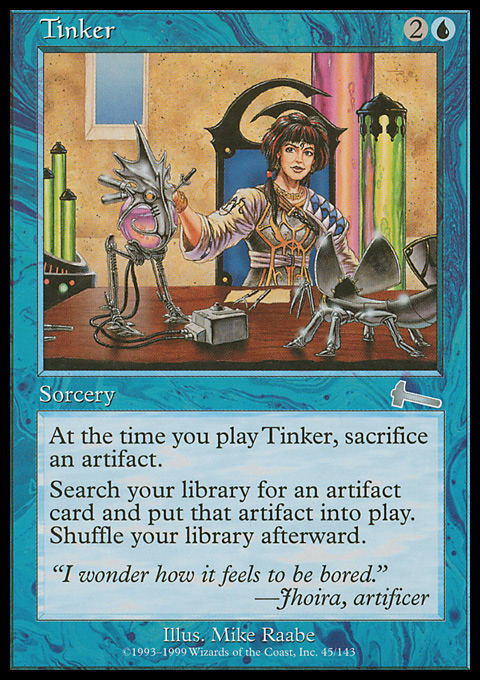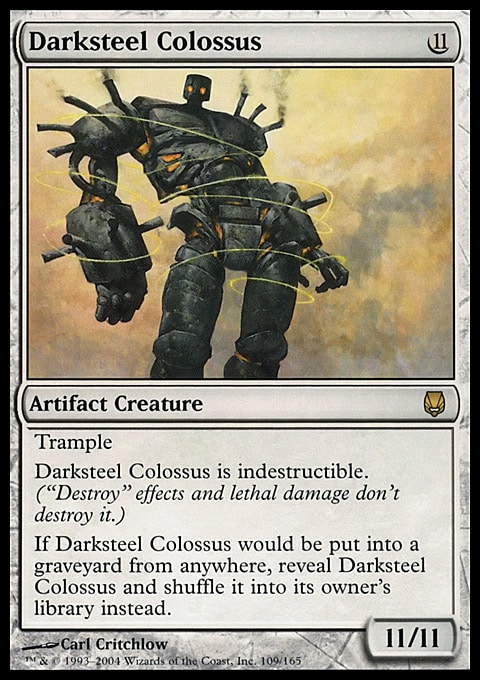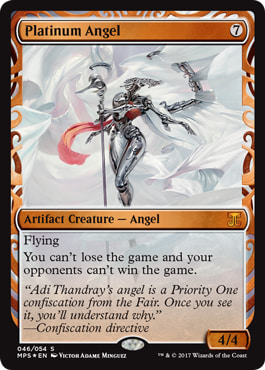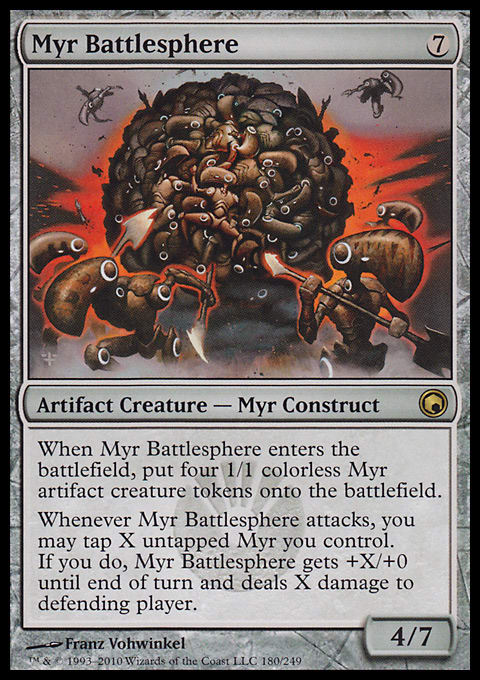The only life that matters in Magic: The Gathering is the last one. I know that’s not brilliant new strategy or anything, but there are so many ways to reach that all-important life point in Vintage that it’s worth examining some of them and the reasons a player would choose one over another. Today, I’m looking at the Tinkerbot!
When Tinker was first introduced in Vintage, it was mostly used to find Memory Jar as an additional 3-drop, draw-seven card. Timetwister and Wheel of Fortune would refuel your opponent for her turn, too, if you couldn’t win, but Memory Jar dodged that by having everyone discard cards they didn’t use. Discarded cards could then also be used with Goblin Welder or Yawgmoth's Will, again, if you didn’t win.
Tinker has limitless potential, though, since it allows players to “cheat” bigger spells into play for the much lower cost of 3 mana. Tinkering a Mox Emerald for Blightsteel Colossus, for example, is like suddenly gaining 9 mana. Because many Vintage decks are so reliant on fast mana like Moxes, Sol Ring, and so on, there’re a good number of low-investment sacrifice opportunities. As it turns out, trading two lesser cards for one giant robot is a solid play—so much so that Tinker for Memory Jar is now almost totally relegated to aggressive combo decks. And Tinker becomes better every time Wizards prints a shiny new, giant robot.
Going back as far as possible in Morphling.de, to April 2002, we see that the first-place Tools ‘n’ Tubbies list used Tinker and included artifact creatures like Masticore and Triskelion (and Su-Chi!), but Tinker here was primarily used to set up a card-draw engine with Memory Jar and Goblin Welder.
Mirrodin’s release brought with it a host of artifact monstrosities, starting with Platinum Angel and Pentavus. Slaver decks started using Platinum Angel and Pentavus as win conditions (or not-lose conditions) almost immediately in 2003. Pentavus was an important combo piece for the deck because it could provide fodder for several Goblin Welder activations to recur the deck’s namesake Mindslavers and effectively lock the opponent out of the game. It was a similar situation to today’s combo of Time Vault and Voltaic Key except that the combo cost significantly more mana and cards to set up.
When Darksteel was printed in 2004, it added Sundering Titan to the format. Titan was good enough on its own since it could destroy multiple dual lands and set an opponent way back on mana, but again, Goblin Welder made Titan more effective, triggering Armageddon repeatedly. (Note: Sundering Titan can choose a dual land once for each of its basic land types. If you and your opponent both control one Underground Sea, you can choose your opponent’s land as both the Swamp and the Island and not lose your own land. However, a land must be chosen for each type, so if the only Forest is your Tropical Island, you have to choose to destroy it. Also note that Titan doesn’t target. Once the ability is allowed to resolve, the lands are chosen and are destroyed. At that point, they can’t be saved by Gush, for example.)
Slaver decks didn’t use Titan for fear of blowing up their own lands, but Five-Color Stax lists made good use of the card. Stax ran Tinker (and Welder) in their suite of broken colored spells and had an impervious mana base that ran no basic land types. Likewise, blue decks today don’t often Tinker for Sundering Titan since it has no evasion and isn’t especially fast. Some control or tempo lists with Wasteland might opt for it to stay ahead of an already down opponent; otherwise, it only shows up in Mishra's Workshop–based MUD lists, especially alongside Kuldotha Forgemaster.
More interesting is the development of lists with one go-to Tinker target. The first instance of a lone artifact creature being played with Tinker, without Memory Jar or Mindslaver, is from a 2004 Rector Donate list with Darksteel Colossus:
Illusions Donate ? Vintage 2004 | Troels Carlsen
- Creatures (5)
- 4 Academy Rector
- 1 Darksteel Colossus
- Spells (37)
- 1 Ancestral Recall
- 1 Mystical Tutor
- 1 Vampiric Tutor
- 2 Brainstorm
- 2 Dark Ritual
- 4 Force of Will
- 1 Balance
- 1 Demonic Tutor
- 1 Tinker
- 2 Donate
- 4 Cabal Therapy
- 4 Duress
- 1 Yawgmoth's Bargain
- 3 Illusions of Grandeur
- 1 Black Lotus
- 1 Chrome Mox
- 1 Lotus Petal
- 1 Mana Crypt
- 1 Mana Vault
- 1 Mox Diamond
- 1 Mox Pearl
- 1 Mox Sapphire
- 1 Sol Ring
- Lands (19)
- 1 Strip Mine
- 2 Polluted Delta
- 4 Flooded Strand
- 4 Scrubland
- 4 Tundra
- 4 Underground Sea
- Sideboard (15)
- 3 Chill
- 2 Disenchant
- 1 Donate
- 1 Flash Flood
- 1 Hydroblast
- 2 Mana Drain
- 3 Maze of Ith
- 1 Orim's Chant
- 1 The Abyss
Honestly, this list (with a few obvious updates) looks like a lot of modern Vintage lists: tutors, disruption, restricted cards, a primary plan of blue-based combo, and a backup win condition in Tinker. If the game was getting out of hand or the opponent was prepared to deal with the primary combo, Tinker could close things quickly and easily. As a two-card throw-in combo, it was easy to protect and a low-risk investment.
From 2005 through 2008, the choice of lone finisher robot was Darksteel Colossus. It was simply the biggest thing available (that didn’t have a drawback like Phyrexian Dreadnought, which has its own storied past). It allowed Tinker to “cheat” a lot of mana into play, and the indestructible and trample keywords were relevant. However, Darksteel Colossus was mostly a big beater: It was susceptible to targeted bounce and Swords to Plowshares; its abilities weren’t enough to win in some complicated situations; and two turns could be too slow against faster opponents. It was still the best option, but opponents were prepared for it.
Having Tinker in the deck also encouraged other artifact-based combos. Similar to Mindslaver, players could play Goblin Charbelcher with Mana Severance and, for a time, Time Vault with Flame Fusillade. One of Time Vault’s many errata, from fall 2005 to spring 2006, allowed it to untap at any time by skipping a prospective future turn. Flame Fusillade turned that into 1 damage, and Tinker helped find Time Vault. Now, of course, Time Vault and Voltaic Key are easy inclusions.
When Future Sight was released in 2007, Platinum Angel had a brief resurgence in popularity thanks to the printing of Pact of Negation. The Angel’s you-can’t-lose-the-game ability paired nicely with Pact’s lose-the-game upkeep trigger, meaning controllers could use as many Pacts as necessary to make sure Tinker resolved and Angel stayed in play. Having three or four additional free counters (along with Force of Will) gave plenty of time for the otherwise slow 4/4 flyer to win the game.
Platinum Control ? Vintage 2007 | Owen Turtenwald
- Creatures (3)
- 3 Platinum Angel
- Spells (42)
- 1 Ancestral Recall
- 1 Echoing Truth
- 1 Fact or Fiction
- 1 Misdirection
- 1 Mystical Tutor
- 4 Brainstorm
- 4 Force of Will
- 4 Mana Drain
- 4 Pact of Negation
- 4 Thirst for Knowledge
- 1 Time Walk
- 1 Tinker
- 2 Ponder
- 4 Merchant Scroll
- 1 Black Lotus
- 1 Mana Crypt
- 1 Mana Vault
- 1 Mox Emerald
- 1 Mox Jet
- 1 Mox Pearl
- 1 Mox Ruby
- 1 Mox Sapphire
- 1 Sol Ring
- Lands (15)
- 5 Island
- 1 Library of Alexandria
- 1 Tolaria West
- 2 Flooded Strand
- 4 Polluted Delta
- 1 Academy Ruins
- 1 Tolarian Academy
- Sideboard (15)
- 2 Hurkyl's Recall
- 4 Leyline of the Void
- 1 Meloku the Clouded Mirror
- 2 Pithing Needle
- 4 Threads of Disloyalty
- 2 Trickbind
Owen Turtenwald played this deck to third place at a StarCityGames Power 9 event in 2007. His wins popularized the idea for a while, and others ran with it, eventually including Oath of Druids, which could similarly be backed up with Pact of Negation. The triggers could be stacked so that Oath resolved to put the Angel into play and then the Pact trigger resolved and didn’t kill you.
Today, Mindbreak Trap and especially Mental Misstep (which counters a lot of problematic creature and artifact removal), along with the unrestriction of Thirst for Knowledge, could make this deck a contender in the current metagame. The question remains whether Platinum Angel is too slow and fragile. Five turns is an awful long time in Vintage.
In 2009, Inkwell Leviathan (Conflux) and Sphinx of the Steel Wind (Alara Reborn) were printed and gave Tinkerbots some color as part of the Esper shard’s every-creature-is-an-artifact schtick. Each has advantages and disadvantages, especially over Darksteel Colossus, and both of them are useable today in the right list and metagame. In both cases, their being blue gave them an additional benefit simply because they could be pitched to Force of Will in a pinch if they were trapped in hand.
Inkwell Leviathan is difficult to deal with once it’s in play. Most blue decks will play some number of Hurkyl's Recall to deal with opposing Mishra's Workshop decks, but it’s hard to justify overloading on them just to deal with a potential Tinker play. Islandwalk and trample mean Inkwell Leviathan can race smaller blue creatures if necessary, but as a 7/11, it can also hold the ground for a long time against a small ground force (it was particularly good against Tarmogoyfs). The disadvantage, of course, is that it almost always takes at least three turns to finish off an opponent.
Inkwell Leviathan is usually best in a blue-heavy control environment, where islandwalk will come into play more easily and where it will often have enough turns to attack. Hexproof used to protect it against Jace, the Mind Sculptor, but it works equally well against Dack Fayden.
Sphinx of the Steel Wind has similar defenses to Inkwell Leviathan since protection from red and green will dodge Dack Fayden, Nature's Claim, Ancient Grudge, Ingot Chewer, Goblin Welder, and other targeted artifact removal and burn spells. Sphinx is also very good against any kind of small creature rush, as would be expected of a creature with flying, lifelink, first strike, and vigilance. I have unpleasant memories of playing R/G Belcher, watching a sizeable turn-one Empty the Warrens fail against a Tinkered up Sphinx.
Sphinx is starting to show up again currently because of its Dack Fayden immunity and since, with lifelink, it can keep a player alive against Young Pyromancer and a decent number of Monastery Mentor tokens. There are also a number of Esper decks that can reasonably hard-cast it, especially with the help of Mana Drain.
I’ve already written here and elsewhere about how important Mirrodin block was for Vintage. Revisiting that plane in Scars of Mirrodin block was equally changing.
Myr Battlesphere was printed in Scars of Mirrodin and offers a new look for Tinker targets—one that goes wide as well as high, bringing with its sizeable body a small but formidable horde of Myr tokens. While Battlesphere has no built-in defensive abilities, the tokens generally survive anything but mass removal. Battlesphere and its minions have additional benefits: providing targets for Goblin Welder or Kuldotha Forgemaster, for example, and powering up Tolarian Academy. It’s also the easiest of the big bots to hard-cast and isn’t an immediate loss if Dack Fayden shows up (though that’s still pretty bad).
These benefits make Battlesphere attractive in combo decks, especially Steel City Vault as below, where it could be effective in the main deck or in the sideboard. (Often, the primary Tinker target will be Memory Jar.) If it can’t win the game on its own, it makes Thoughtcast, Tolarian Academy, and Goblin Welder into significant threats. Early on, it was also used in Fastbond–Gush decks (sometimes with Lotus Cobra), where its simple, relatively small casting cost could come into play as a finisher.
Steel City Vault ? Vintage 2014 | Paul Mastriano
- Creatures (2)
- 2 Goblin Welder
- Planeswalkers (2)
- 2 Dack Fayden
- Spells (45)
- 1 Ancestral Recall
- 1 Brainstorm
- 1 Fire // Ice
- 1 Gifts Ungiven
- 1 Hurkyl's Recall
- 1 Mystical Tutor
- 1 Thirst For Knowledge
- 1 Vampiric Tutor
- 4 Force of Will
- 1 Demonic Tutor
- 1 Imperial Seal
- 1 Ponder
- 1 Regrowth
- 1 Time Walk
- 1 Timetwister
- 1 Tinker
- 1 Wheel of Fortune
- 1 Yawgmoth's Will
- 2 Burning Wish
- 3 Thoughtcast
- 1 Black Lotus
- 1 Lotus Petal
- 1 Mana Crypt
- 1 Mana Vault
- 1 Memory Jar
- 1 Mox Emerald
- 1 Mox Jet
- 1 Mox Pearl
- 1 Mox Ruby
- 1 Mox Sapphire
- 1 Nihil Spellbomb
- 1 Sol Ring
- 1 Time Vault
- 2 Voltaic Key
- 4 Mox Opal
- Lands (11)
- 2 City of Brass
- 4 Mana Confluence
- 1 Tolarian Academy
- 4 Seat of the Synod
- Sideboard (15)
- 1 Nihil Spellbomb
- 1 Myr Battlesphere
- 1 Ancient Grudge
- 2 Misdirection
- 3 Nature's Claim
- 1 Balance
- 1 Mind Twist
- 1 Tendrils of Agony
- 1 Transmute Artifact
- 1 Vandalblast
- 1 Void Snare
- 1 Windfall
Vintage changed immediately when Blightsteel Colossus was printed in February 2011. It has all the benefits of Darksteel Colossus, and it kills in one hit. The difference between one turn and two or three turns may not seem like a lot—and it’s not in other formats—but when decisions and actions are compressed as they are in Vintage, it can be an eternity. Blightsteel Colossus is the ultimate question—opponents are forced to find an answer or die.
Until they print a Tinker target with haste, Blightsteel Colossus will be an option, and a high-ranking one. If you’re unsure of your deck, your ability, or the environment you’ll be playing in, it’s difficult to argue against Ol’ Blighty. Other options, especially Sphinx of the Steel Wind, Inkwell Leviathan, and Myr Battlesphere, could be more correct given certain expectations. Regardless, Vintage players will keep expecting to face (and sometimes lose to) giant robots.
Thanks for reading!
Nat Moes



























